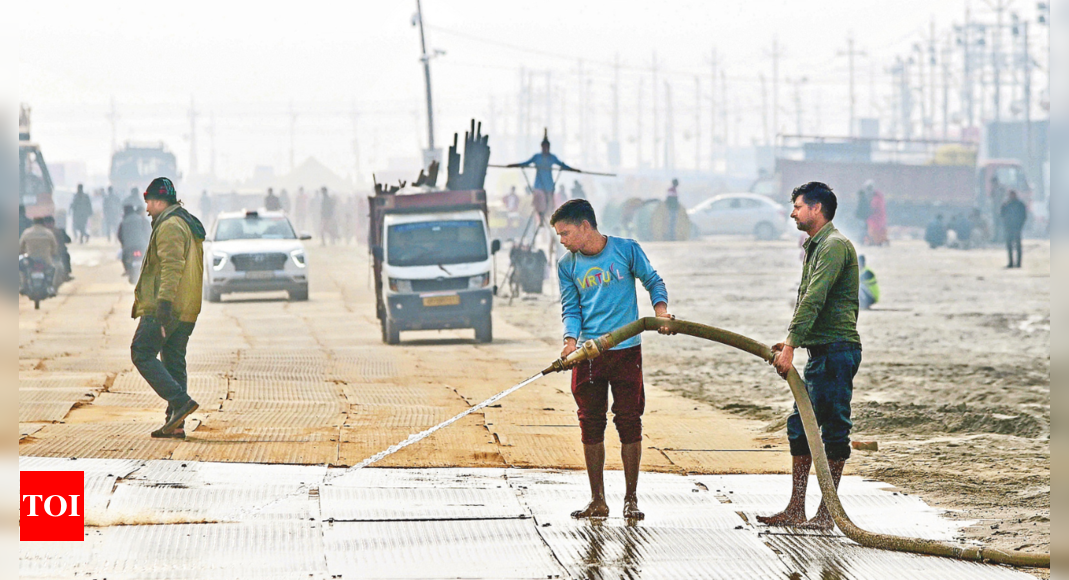The Prayagraj Mela Authority has hired nearly 10,000 sanitation workers to ensure a clean Maha Kumbh. Through the Swachh Kumbh Fund, the government provides them with free accommodation, food and education for their children. Eco-friendly equipment is used that operates without fuel or electricity, which helps reduce environmental impact.
Being operated manually, the equipment does not raise dust and its ergonomic design guarantees comfort during use.
1.5 lakh toilets in mela area
under the Swachh Kumbh InitiativeThe Prayagraj Mela Authority has installed around 1.5 lakh toilets and urinals in the Maha Kumbh area.
Sanitation infrastructure includes water jetting systems and a comprehensive cesspool operation plan, along with provisions such as septic tanks and soak pits.
To ensure cleanliness and safety, all facilities are being monitored using QR codes. A total of 55 vendors have been selected for the large-scale installation, ensuring that devotees and visitors have access to community toilets.
Advanced equipment, including 10 hand-held sweepers and two battery-operated vacuum cleaner garbage collectors worth Rs 45 lakh, are being deployed at the mela area.
A compact manual sweeping machine has also been deployed to clean paved ghats, footpaths, roads and public places within the mela area, enhancing convenience and experience for devotees, tourists and bathers from the country and abroad.
This eco-friendly equipment operates without fuel or electricity, helping to reduce its environmental impact. Being manually operated, it cleans effectively without raising dust, and its ergonomic design guarantees comfort during use.
The machine’s efficiency in road cleaning makes it easy to operate and maintain, allowing sanitation workers to perform their tasks effectively while contributing to a cleaner, greener environment.
A battery-operated vacuum-type garbage collector is installed in the mela area. It is a battery-operated, ride-on and walk-behind electric suction vacuum cleaner designed to pick up trash and debris. Its compact size allows easy operation in any part of the fair, ensuring deep cleaning of various surfaces. Attached to a vehicle, this advanced equipment offers excellent mobility and eliminates the need for manual labor. Its powerful suction function ensures fast and efficient waste collection, while its long-lasting battery reduces environmental impact and carbon emissions.
Automatic fog and blower machines for kumbh without mosquitoes
The health department has introduced special measures for both saints and devotees, with an aim to make the Kumbh area free of mosquitoes and flies. To effectively address insect-related problems, an innovative system has been introduced using automatic fog machines capable of eradicating mosquitoes and flies within 30 minutes after receiving a call from anywhere in the mela area. A total of 110 latest generation fogging machines and 107 mini foggers are being deployed in the mela area. These modern devices are expected to enhance the overall experience of the devotees.
At least 45 malaria inspectors have been assigned duties, along with 28 assistant malaria inspectors who will ensure the welfare of seers and devotees. Five district malaria officers (DMOs) have also been separately posted to address any challenges and keep services uninterrupted.
Cleaning monitoring based on QR codes
Apart from the installation of 1.5 lakh toilets and urinals, a QR code-based monitoring system is being launched to track the level of sanitation in the toilets. Any report of dirty facilities will trigger immediate action via a dedicated app, allowing for quick cleaning within minutes. Additionally, a water jet cleaning system has been introduced which will eliminate the need for manual cleaning. There is also a cesspool operation plan to effectively manage septic tanks. The responsibility of monitoring these toilets has been entrusted to 1,500 Ganga Sevadoots, who will inspect each toilet every morning and evening. Using an ICT app, they will scan each facility’s QR code and answer a series of yes or no questions, such as whether the toilet is clean, whether the door is intact and whether there is enough water.
At least 500 dedicated Ganga Praharis work round the clock to ensure the cleanliness and purity of the rivers. The Ganga Praharis, known as vigilant guardians of the cleanliness of the rivers, are assigned duties at the 41 ghats. Working in teams of 15 to 20 people at each ghat and operating in shifts during the Maha Kumbh, they not only clean the rivers and ghats but also educate devotees about the importance of preserving the sanctity of the rivers. Under the Namami Gange project, the ‘Ganga Praharis’ are dedicated to ensuring the cleanliness of rivers and ghats while conserving aquatic life, in collaboration with the Wildlife Institute of India. They are also carrying out round-the-clock cleaning drives, using nets to remove waste from rivers and ghats.
Swachhta mitra suraksha bima scheme
The Swachhta Mitra Suraksha Bima scheme will provide comprehensive life and health insurance coverage to healthcare workers, ensuring their safety during the mega event. The Prayagraj Mela Authority has installed 1.5 lakh toilets across the Mela area and more than 10,000 sanitation workers have also been deployed to maintain cleanliness throughout the event. Under the Swachhta Mitra Suraksha Bima scheme, all healthcare workers and seafarers involved in Mahakumbh will be given a life insurance cover of Rs 2 lakh.




